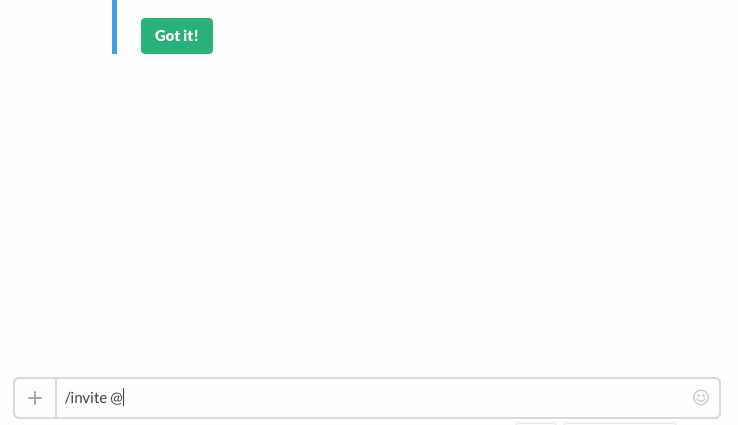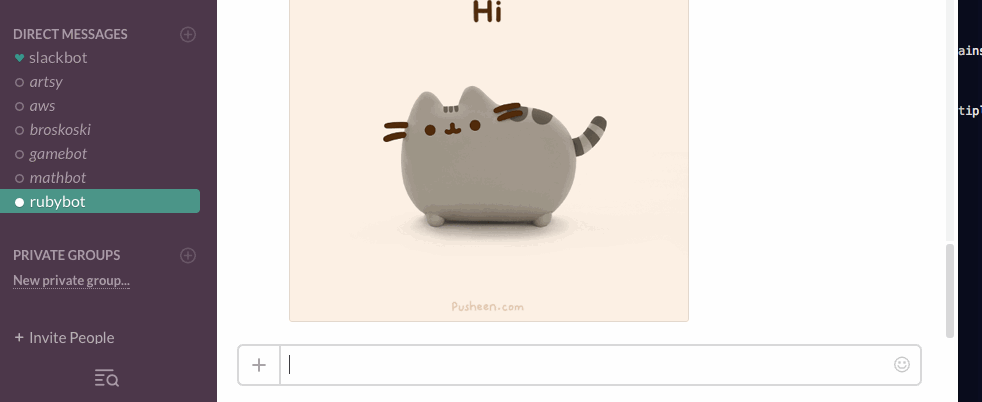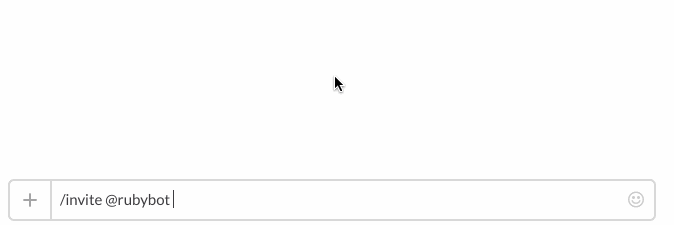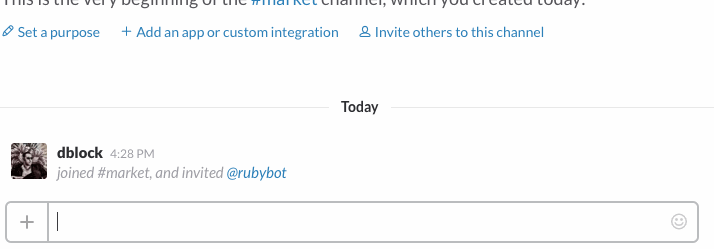Slack-Ruby-Bot
A generic Slack bot framework written in Ruby on top of slack-ruby-client. This library does all the heavy lifting, such as message parsing, so you can focus on implementing slack bot commands. It also attempts to introduce the bare minimum number of requirements or any sorts of limitations. It's a Slack bot boilerplate.
If you are not familiar with Slack bots or Slack API concepts, you might want to watch this video.
Useful to Me?
- If you are just trying to send messages to Slack, use slack-ruby-client, which this library is built on top of.
- If you're trying to roll out a full service with Slack button integration, check out slack-ruby-bot-server, which uses this library.
- Otherwise, this piece of the puzzle will help you create a single bot instance for one team.
Stable Release
You're reading the documentation for the next release of slack-ruby-bot. Please see the documentation for the last stable release, v0.10.5 unless you're integrating with HEAD. See CHANGELOG for a history of changes and UPGRADING for how to upgrade to more recent versions.
Usage
A Minimal Bot
Gemfile
source 'https://rubygems.org'
gem 'slack-ruby-bot'
gem 'celluloid-io'pongbot.rb
require 'slack-ruby-bot'
class PongBot < SlackRubyBot::Bot
command 'ping' do |client, data, match|
client.say(text: 'pong', channel: data.channel)
end
end
PongBot.runAfter registering the bot, run with SLACK_API_TOKEN=... bundle exec ruby pongbot.rb. Have the bot join a channel and send it a ping.
A Production Bot
A typical production Slack bot is a combination of a vanilla web server and a websocket application that talks to the Slack Real Time Messaging API. See our Writing a Production Bot tutorial for more information.
More Involved Examples
The following examples of bots based on slack-ruby-bot are listed in growing order of complexity.
- slack-bot-on-rails: A bot running on Rails and using React to display Slack messages on a website.
- slack-mathbot: Slack integration with math.
- slack-google-bot: A Slack bot that searches Google, including CSE.
- slack-aws: Slack integration with Amazon Web Services.
- slack-deploy-bot: A Slack bot that helps you to deploy your apps.
- slack-gamebot: A game bot service for ping pong, chess, etc, hosted at playplay.io.
- slack-victorbot: A Slack bot to talk to the Victorops service.
Commands and Operators
Bots are addressed by name, they respond to commands and operators. You can combine multiple commands.
class CallBot < SlackRubyBot::Bot
command 'call', '呼び出し' do |client, data, match|
client.say(channel: data.channel, text: 'called')
end
endCommand match data includes match['bot'], match['command'] and match['expression']. The bot match always checks against the SlackRubyBot::Config.user and SlackRubyBot::Config.user_id values obtained when the bot starts.
The command method can take strings, which will have be escaped with Regexp.escape, and regular expressions.
class CallBot < SlackRubyBot::Bot
command 'string with spaces', /some\s*regex+\?*/ do |client, data, match|
client.say(channel: data.channel, text: match['command'])
end
endOperators are 1-letter long and are similar to commands. They don't require addressing a bot nor separating an operator from its arguments. The following class responds to =2+2.
class MathBot < SlackRubyBot::Bot
operator '=' do |client, data, match|
# implementation detail
end
endOperator match data includes match['operator'] and match['expression']. The bot match always checks against the SlackRubyBot::Config.user setting.
Bot Aliases
A bot will always respond to its name (eg. rubybot) and Slack ID (eg. @rubybot), but you can specify multiple aliases via the SLACK_RUBY_BOT_ALIASES environment variable or via an explicit configuration.
SLACK_RUBY_BOT_ALIASES=:pp: table-tennis
SlackRubyBot.configure do |config|
config.aliases = [':pong:', 'pongbot']
endThis is particularly fun with emoji.
Bots also will respond to a direct message, with or without the bot name in the message itself.
Generic Routing
Commands and operators are generic versions of bot routes. You can respond to just about anything by defining a custom route.
class Weather < SlackRubyBot::Bot
match /^How is the weather in (?<location>\w*)\?$/ do |client, data, match|
client.say(channel: data.channel, text: "The weather in #{match[:location]} is nice.")
end
endYou can also capture multiple matchers with scan.
class Market < SlackRubyBot::Bot
scan(/([A-Z]{2,5})/) do |client, data, stocks|
# lookup stock market price
end
endSee examples/market for a working example.
Providing description for your bot and commands
You can specify help information for bot or commands with help block, for example:
in case of bot:
class WeatherBot < SlackRubyBot::Bot
help do
title 'Weather Bot'
desc 'This bot tells you the weather.'
command 'clouds' do
desc 'Tells you how many clouds there\'re above you.'
end
command 'What\'s the weather in <city>?' do
desc 'Tells you the weather in a <city>.'
long_desc "Accurate 10 Day Weather Forecasts for thousands of places around the World.\n" \
'Bot provides detailed Weather Forecasts over a 10 day period updated four times a day.'
end
end
# commands implementation
endin case of your own command:
class Deploy < SlackRubyBot::Commands::Base
help do
title 'deploy'
desc 'deploys your app'
long_desc 'command format: *deploy <branch> to <env>* where <env> is production or staging'
end
endSlackRubyBot::Commands::Base
The SlackRubyBot::Bot class is DSL sugar deriving from SlackRubyBot::Commands::Base. For more involved bots you can organize the bot implementation into subclasses of SlackRubyBot::Commands::Base manually. By default a command class responds, case-insensitively, to its name. A class called Phone that inherits from SlackRubyBot::Commands::Base responds to phone and Phone and calls the call method when implemented.
class Phone < SlackRubyBot::Commands::Base
command 'call'
def self.call(client, data, match)
client.say(channel: data.channel, text: 'called')
end
endTo respond to custom commands and to disable automatic class name matching, use the command keyword. The following command responds to call and 呼び出し (call in Japanese).
class Phone < SlackRubyBot::Commands::Base
command 'call'
command '呼び出し'
def self.call(client, data, match)
client.say(channel: data.channel, text: 'called')
end
endAuthorization
The framework does not provide any user authentication or command authorization capability out of the box. However, the SlackRubyBot::Commands::Base class does check every command invocation for permission prior to executing the command. The default method always returns true.
Therefore, subclasses of SlackRubyBot::Commands::Base can override the permitted? private method to provide its own authorization logic. This method is intended to be exploited by user code or external gems that want to provide custom authorization logic for command execution.
class AuthorizedBot < SlackRubyBot::Commands::Base
command 'phone home' do |client, data, match|
client.say(channel: data.channel, text: 'Elliot!')
end
# Only allow user 'Uxyzabc' to run this command
def self.permitted?(client, data, match)
data && data.user && data.user == 'Uxyzabc'
end
endAnimated GIFs
The SlackRubyBot::Client implementation comes with GIF support.
To enable it simply add gem 'giphy' to your Gemfile.
Note: Bots send animated GIFs in default commands and errors.
class Phone < SlackRubyBot::Commands::Base
command 'call'
def self.call(client, data, match)
client.say(channel: data.channel, text: 'called', gif: 'phone')
# Sends the text 'called' and a random GIF that matches the keyword 'phone'.
end
endIf you use giphy for something else but don't want your bots to send GIFs you can set ENV['SLACK_RUBY_BOT_SEND_GIFS'] or SlackRubyBot::Config.send_gifs to false. The latter takes precedence.
SlackRubyBot.configure do |config|
config.send_gifs = false
endBuilt-In Commands
Slack-ruby-bot comes with several built-in commands. You can re-define built-in commands, normally, as described above.
[bot name]
This is also known as the default command. Shows bot version and links.
[bot name] hi
Politely says 'hi' back.
[bot name] help
Get help.
Hooks
Hooks are event handlers and respond to Slack RTM API events, such as hello or message. You can implement your own in a couple of ways:
Implement and register a Hook Handler
A Hook Handler is any object that respond to a call message, like a proc, instance of an object, class with a call class method, etc.
Hooks can be registered using different methods based on user preference / use case. Currently someone can use one of the following methods:
- Pass
hooksinSlackRubyBot::Serverinitialization. - Register
hooksonSlackRubyBot::Serverusingonclass method. - Register
hooksonSlackRubyBot::Serverusingoninstance method.
Hooks registration on SlackRubyBot::Server initialization
SlackRubyBot::Server.new(hook_handlers: {
hello: MyBot::Hooks::UserChange.new,
user_change: [->(client, data) { }, ->(client, data) {}]
})Hooks registration on a SlackRubyBot::Server instance
# Register an object that implements `call` method
class MyBot::Hooks::Hello
def call(client, data)
puts "Hello"
end
end
server.on(:hello, MyBot::Hooks::Hello.new)
# or register a lambda function to handle the event
server.on(:hello, ->(client, data) { puts "Hello!" })For example, the following hook handles user_change, an event sent when a team member updates their profile or data. This can be useful to update the local user cache when a user is renamed.
module MyBot
module Hooks
class UserChange
def call(client, data)
# data['user']['id'] contains the user ID
# data['user']['name'] contains the new user name
# ...
end
end
end
endHooks registration on SlackRubyBot::Server class
Example:
module MyBot
class MyServer < SlackRubyBot::Server
on 'hello' do |client, data|
# data['user']['id'] contains the user ID
# data['user']['name'] contains the new user name
end
on 'user_change', ->(client, data) {
# data['user']['id'] contains the user ID
# data['user']['name'] contains the new user name
}
end
endThese will get pushed into the hook set on initialization.
Either by configuration, explicit assignment or hook blocks, multiple handlers can exist for the same event type.
Deprecated hook registration
Registering a hook method using hooks.add is considered deprecated and
will be removed on future versions.
# [DEPRECATED]
server.hooks.add(:hello, MyBot::Hooks::UserChange.new)
server.hooks.add(:hello, ->(client, data) { puts "Hello!" })Message Loop Protection
By default bots do not respond to their own messages. If you wish to change that behavior, set allow_message_loops to true.
SlackRubyBot.configure do |config|
config.allow_message_loops = true
endLogging
By default bots set a logger to $stdout with DEBUG level. The logger is used in both the RealTime and Web clients.
Silence logger as follows.
SlackRubyBot::Client.logger.level = Logger::WARNIf you wish to customize logger, set logger to your logger.
SlackRubyBot.configure do |config|
config.logger = Logger.new("slack-ruby-bot.log", "daily")
endAdvanced Integration
You may want to integrate a bot or multiple bots into other systems, in which case a globally configured bot may not work for you. You may create instances of SlackRubyBot::Server which accepts token, aliases and send_gifs.
EM.run do
bot1 = SlackRubyBot::Server.new(token: token1, aliases: ['bot1'])
bot1.start_async
bot2 = SlackRubyBot::Server.new(token: token2, send_gifs: false, aliases: ['bot2'])
bot2.start_async
endFor an example of advanced integration that supports multiple teams, see slack-gamebot and playplay.io that is built on top of it.
Model-View-Controller Design
The command method is essentially a controller method that receives input from the outside and acts upon it. Complex behaviors could lead to a long and difficult-to-understand command block. A complex command block is a candidate for separation into classes conforming to the Model-View-Controller pattern popularized by Rails.
The library provides three helpful base classes named SlackRubyBot::MVC::Model::Base, SlackRubyBot::MVC::View::Base, and SlackRubyBot::MVC::Controller::Base.
Testing a command block is difficult. As separate classes, the Model/View/Controller's behavior can be tested via rspec or a similar tool.
Controller
The Controller is the focal point of the bot behavior. Typically the code that would go into the command block will now go into an instance method in a Controller subclass. The instance method name should match the command name exactly (case sensitive).
As an example, these two classes are functionally equivalent.
Consider the following Agent class which is the simplest default approach to take.
class Agent < SlackRubyBot::Bot
command 'sayhello', 'alternate way to call hello' do |client, data, match|
client.say(channel: data.channel, text: "Received command #{match[:command]} with args #{match[:expression]}")
end
endUsing the MVC functionality, we would create a controller instead to encapsulate this function.
class MyController < SlackRubyBot::MVC::Controller::Base
def sayhello
client.say(channel: data.channel, text: "Received command #{match[:command]} with args #{match[:expression]}")
end
alternate_name :sayhello, :alternate_way_to_call_hello
end
MyController.new(MyModel.new, MyView.new)Note in the above example that the Controller instance method sayhello does not receive any arguments. When the instance method is called, the Controller class sets up some accessor methods to provide the normal client, data, and match objects. These are the same objects passed to the command block.
However, the Controller anticipates that the model and view objects should contain business logic that will also operate on the client, data, and match objects. The controller provides access to the model and view via the model and view accessor methods. The inventory example provides a full example of a Model, View, and Controller working together.
A Controller may need helper methods for certain work. To prevent the helper method from creating a route that the bot will respond to directly, the instance method name should begin with an underscore (e.g. _my_helper_method). When building the bot routes, these methods will be skipped.
Calling alternate_name after the method definition allows for method aliases similar to the regular command structure. When commands can be triggered by multiple text strings it's useful to have that ability map to the controller methods too.
Lastly, the Controller class includes ActiveSupport::Callbacks which allows for full flexibility in creating before, after, and around hooks for all methods. Again, see the inventory example for more information.
Model
A complex bot may need to read or write data from a database or other network resource. Setting up and tearing down these connections can be costly, so the model can do it once upon instantiation.
The Model also includes ActiveSupport::Callbacks.
class MyModel < SlackRubyBot::MVC::Model::Base
define_callbacks :sanitize
set_callback :sanitize, :around, :sanitize_resource
attr_accessor :_resource
def initialize
@db = setup_database_connection
end
def read(resource)
self._resource = resource
run_callbacks :sanitize do
@db.select(:column1 => resource)
# ... do some expensive work
end
end
private
def sanitize_resource
self._resource.downcase
result = yield
puts "After read, result is #{result.inspect}"
end
endLike Controllers, the Model is automatically loaded with the latest version of the client, data, and match objects each time the controller method is called. Therefore the model will always have access to the latest objects when doing its work. It will typically only use the data and match objects.
Model methods are not matched to routes, so there is no restriction on how to name methods as there is in Controllers.
View
A typical bot just writes to a channel or uses the web client to react/unreact to a message. More complex bots will probably require more complex behaviors. These should be stored in a SlackRubyBot::MVC::View::Base subclass.
class MyView < SlackRubyBot::MVC::View::Base
define_callbacks :logit
set_callbacks :logit, :around, :audit_trail
def initialize
@mailer = setup_mailer
@ftp = setup_ftp_handler
end
def email_admin(message)
run_callbacks :logit do
@mailer.send(:administrator, message)
end
end
def react_thumbsup
client.web_client.reactions_add(
name: :thumbs_up,
channel: data.channel,
timestamp: data.ts,
as_user: true)
end
def react_thumbsdown
client.web_client.reactions_remove(
name: :thumbs_up,
channel: data.channel,
timestamp: data.ts,
as_user: true)
end
private
def audit_trail
Logger.audit("Sending email at [#{Time.now}]")
yield
Logger.audit("Email sent by [#{Time.now}]")
end
endAgain, the View will have access to the most up to date client, data, and match objects. It will typically only use the client and data objects.
View methods are not matched to routes, so there is no restriction on how to name methods as there is in Controllers.
RSpec Shared Behaviors
Slack-ruby-bot ships with a number of shared RSpec behaviors that can be used in your RSpec tests.
- behaves like a slack bot: A bot quacks like a Slack Ruby bot.
- respond with slack message: The bot responds with a message.
- respond with slack messages: The bot responds with a multiple messages.
- respond with error: An exception is raised inside a bot command.
Require slack-ruby-bot/rspec in your spec_helper.rb along with the following dependencies in Gemfile.
group :development, :test do
gem 'rspec'
gem 'vcr'
gem 'webmock'
endUseful Libraries
- newrelic-slack-ruby-bot: NewRelic instrumentation for slack-ruby-bot.
Contributing
See CONTRIBUTING.
Upgrading
See CHANGELOG for a history of changes and UPGRADING for how to upgrade to more recent versions.
Copyright and License
Copyright (c) 2015-2016, Daniel Doubrovkine, Artsy and Contributors.
This project is licensed under the MIT License.






